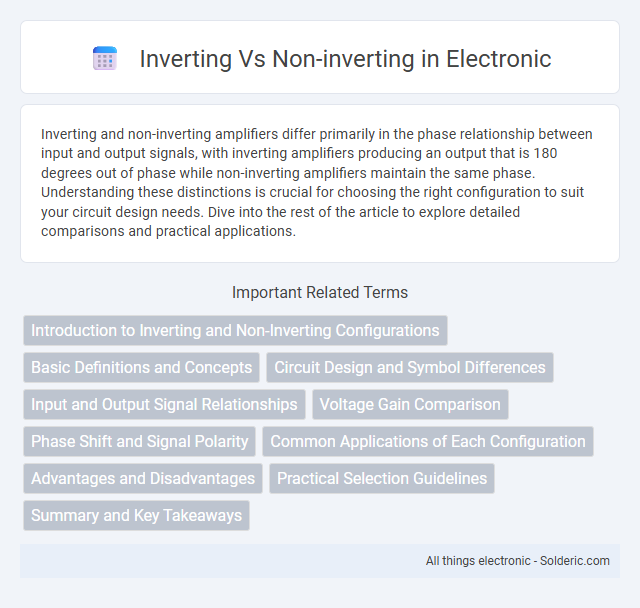Inverting and non-inverting amplifiers differ primarily in the phase relationship between input and output signals, with inverting amplifiers producing an output that is 180 degrees out of phase while non-inverting amplifiers maintain the same phase. Understanding these distinctions is crucial for choosing the right configuration to suit your circuit design needs. Dive into the rest of the article to explore detailed comparisons and practical applications.
Comparison Table
| Feature | Inverting Amplifier | Non-inverting Amplifier |
|---|---|---|
| Input Signal | Applied to the inverting input (-) | Applied to the non-inverting input (+) |
| Phase Relationship | Output is 180deg out of phase with input | Output is in phase with input |
| Voltage Gain | Gain = - (Rf / Rin) (Negative gain) | Gain = 1 + (Rf / Rin) (Positive gain) |
| Input Impedance | Low, approximately equal to Rin | High, very high input impedance (~infinite) |
| Output Impedance | Low | Low |
| Common Applications | Signal inversion, summing amplifier, integrators | Buffer amplifier, voltage follower, impedance matching |
Introduction to Inverting and Non-Inverting Configurations
Inverting and non-inverting configurations are fundamental amplifier setups within operational amplifier circuits, defining how input signals are processed and output signals generated. In an inverting amplifier, the input signal is applied to the inverting input, producing an output that is 180 degrees out of phase with the input, whereas a non-inverting amplifier applies the input to the non-inverting terminal, maintaining the phase of the input signal at the output. Understanding these configurations helps you select the appropriate amplifier design for signal amplification with desired phase and gain characteristics.
Basic Definitions and Concepts
Inverting and non-inverting configurations refer to two fundamental ways operational amplifiers process input signals, with inverting amplifiers reversing the input signal's phase by 180 degrees and non-inverting amplifiers maintaining the input signal's phase. Understanding these configurations is crucial for designing circuits with specific gain and phase characteristics, where the inverting amplifier uses the input signal at its negative terminal, and the non-inverting amplifier applies the input at its positive terminal. Your choice between inverting and non-inverting setups will directly impact signal behavior, gain stability, and impedance properties in analog circuit designs.
Circuit Design and Symbol Differences
Inverting and non-inverting amplifiers differ fundamentally in circuit design: an inverting amplifier connects the input signal to the op-amp's inverting terminal, producing an output signal 180 degrees out of phase, while a non-inverting amplifier feeds the input into the non-inverting terminal, maintaining the same phase. The schematic symbols reflect this distinction with a minus sign (-) at the input for inverting and a plus sign (+) for non-inverting configurations. Understanding these symbol and design differences is crucial for correctly interpreting and implementing your amplification circuits in electronic projects.
Input and Output Signal Relationships
Inverting amplifiers produce an output signal that is 180 degrees out of phase with the input, causing the output voltage to be the negative gain multiplied by the input voltage. Non-inverting amplifiers maintain the same phase as the input signal, with the output voltage being the positive gain multiplied by the input voltage. Understanding these signal relationships is crucial for your applications requiring precise phase control and signal inversion.
Voltage Gain Comparison
Inverting amplifiers provide a voltage gain defined by the ratio of the feedback resistor to the input resistor, resulting in a negative gain that inverts the input signal phase. Non-inverting amplifiers offer a positive voltage gain calculated as one plus the ratio of the feedback resistor to the input resistor, maintaining the input signal phase. The gain magnitude in both configurations depends on resistor values but differs in phase and minimum gain achievable, with non-inverting amplifiers always having a gain of at least one.
Phase Shift and Signal Polarity
Inverting amplifiers produce a 180-degree phase shift, causing the output signal to be the opposite polarity of the input. Non-inverting amplifiers maintain the same phase and polarity, delivering an output signal in phase with the input. Understanding these differences is crucial for designing circuits where signal phase and polarity directly impact performance and signal integrity.
Common Applications of Each Configuration
Inverting amplifiers are widely used in audio mixers and active filters due to their precise phase inversion and gain control capabilities, making them ideal for signal processing tasks. Non-inverting amplifiers are commonly employed in buffer stages, sensor signal conditioning, and voltage followers because they provide high input impedance and unity gain, preserving signal integrity. Both configurations are essential in instrumentation applications where accurate amplification and signal isolation are required.
Advantages and Disadvantages
Inverting amplifiers offer precise phase inversion and easy gain adjustment with a simple resistor network, making them ideal for signal processing where phase shift is needed, but they require a virtual ground and can introduce input bias current errors. Non-inverting amplifiers provide high input impedance and no phase inversion, resulting in minimal signal distortion and better compatibility with high-impedance sources, though they generally have lower bandwidth compared to inverting configurations. Choosing between the two depends on specific application needs such as input impedance requirements, phase considerations, and gain accuracy.
Practical Selection Guidelines
Select an inverting amplifier configuration when phase inversion is acceptable, precise gain control is required, and input impedance matching is less critical. Choose a non-inverting amplifier for applications demanding high input impedance, minimal signal distortion, and maintaining signal phase. Consider factors like noise levels, bandwidth, and feedback network complexity to optimize performance for specific circuit requirements.
Summary and Key Takeaways
Inverting amplifiers provide phase inversion with input signals applied to the inverting terminal, resulting in an output signal 180 degrees out of phase, whereas non-inverting amplifiers maintain the input signal phase by applying input to the non-inverting terminal. Inverting configurations offer precise gain control via the ratio of feedback and input resistors, making them ideal for signal inversion and summing applications. Non-inverting amplifiers deliver high input impedance and unity or greater gain, favoring signal buffering and amplification without phase alteration.
Inverting vs Non-inverting Infographic

 solderic.com
solderic.com